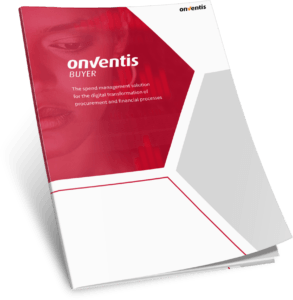An insight into e-procurement: Understanding the definition and process for successful procurement
E-procurement (also known as eProcurement) is short for electronic procurement and refers to the digital purchasing of goods and services by companies. This process involves the use of technologies that promote and digitalise the purchasing department.

What is e-procurement? An introduction to the electronic procurement process
E-procurement (also known as eProcurement) is short for electronic procurement and refers to the digital purchasing of goods and services by companies. This process involves the use of technologies that promote and digitalise the purchasing department. The administration of procurement processes takes place over so-called e-procurement systems which optimise procurement strategies and aid in the achievement of procurement goals.
Specifically, e-procurement is a crucial element of Procurement 4.0, an innovative approach that employs digital solutions and technologies in the procurement process to enhance efficiency, accuracy, agility, and compliance. With the help of e-procurement systems, procurement processes are simplified and optimised through digital platforms. This fosters interactive collaboration among all parties involved in a supply chain. E-procurement systems ensure automated, cross-company networking along the entire supply chain, from start to finish.
What does the e-procurement process look like?
E-procurement integrates seamlessly with every phase of the procurement cycle, from sourcing and purchasing to spend analytics. It fully envelops the entire source-to-pay process, optimizing efficiency and aligning strategically with business objectives. Below is an in-depth exploration of the capabilities of e-procurement at each stage:
Requirements
The e-procurement process begins with defining requirements. This involves identifying necessary goods or services, determining the required quantity, quality standards, delivery timeframes, and other pertinent specifications. E-procurement platforms enable buyers to define these requirements digitally, providing a clear and efficient overview, which helps in tracking and managing requests throughout the procurement cycle.
Supplier management
E-procurement systems play a crucial role in supplier management by supporting the analysis, evaluation, and qualification of suppliers. These systems facilitate the search for the best options that align with the procurer’s needs and strategic objectives, ensuring the selection of the most suitable supplier.
Read more
Contract management
Following supplier selection, the focus shifts to negotiating prices, terms, and conditions. E-procurement platforms offer a streamlined communication channel for all parties involved, enabling easy information exchange and discussion initiation directly through the system.
Read more
Order Management
Once the supplier and terms are finalized, the next step is order placement. E-procurement automates the order management workflow, allowing orders to be created, approved, and monitored electronically. This automation ensures that the process is under constant supervision, enhancing control and efficiency.
Read more
Payment
E-procurement simplifies payment processes through automated systems that reduce manual efforts. Features like Robotic Accounting utilize algorithms for swift invoice capturing, processing, and approval, thus freeing accounting professionals to focus on strategic financial activities rather than routine tasks. This automation enhances efficiency and reduces the scope for errors.
Read more
Spend analytics
E-procurement enables robust data collection and analysis concerning procurement activities. This data provides critical insights into expenditure patterns, supplier performance, and cost management, facilitating strategic decisions and continual improvement of procurement practices.
Read more
Compliance and Risk Management
In addition to the core processes, e-procurement systems help ensure compliance with industry standards and internal policies. They also assess and mitigate risks by providing comprehensive visibility into transactions and supplier relationships, enhancing governance and control throughout the procurement cycle.
By integrating these elements, e-procurement not only simplifies and speeds up the procurement process but also adds strategic value by improving compliance, managing risks, and driving cost efficiencies. This makes e-procurement an indispensable tool for modern businesses aiming to optimize their procurement operations.
The Power of Procurement
The adoption of e-procurement systems brings a multitude of advantages to organizations, encompassing enhanced transparency, superior data quality, and significant cost reductions in procurement activities. These benefits collectively streamline operations and foster a strategic advantage in business procurement practices. For a comprehensive exploration of how e-procurement can transform your business, delve into our detailed blog article “The power of procurement: Discover the concrete benefits of e-procurement” Read all about the strategic value and tangible benefits that e-procurement can offer to your organization.
Weitere BlogsMore BlogsMeer blogs





